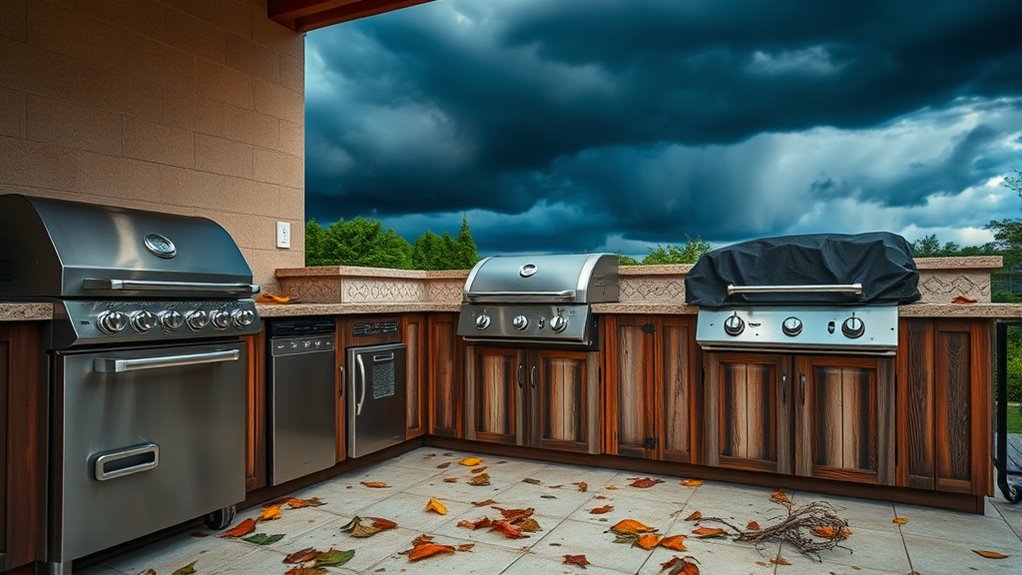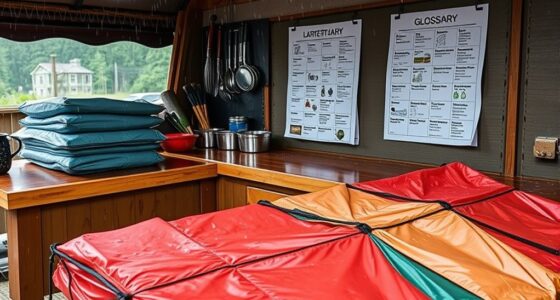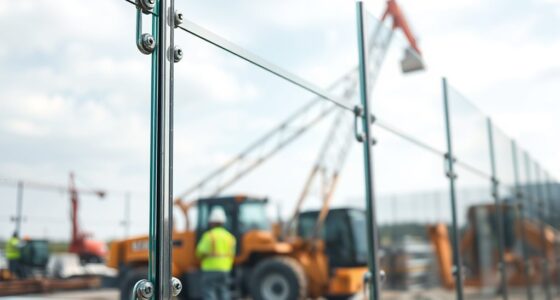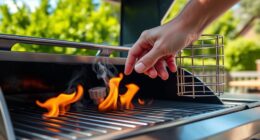Many people believe their outdoor kitchen is fully weatherproof, but heavy storms can still cause damage if you don’t take extra steps. It’s vital to cover or move equipment, secure valuables, and manage drainage systems properly. Wind and debris can damage fixtures and surfaces more than you expect. Relying only on weather-resistant materials won’t prevent deterioration without regular inspections and maintenance. To keep your setup safe and lasting, understanding these common mistakes is key—exploring further will help you stay prepared.
Key Takeaways
- Assuming outdoor kitchens are fully weatherproof without additional protective measures increases damage risk during heavy storms.
- Not covering or securing appliances and furniture before storms leaves them vulnerable to debris, wind, and water damage.
- Overlooking structural components like support beams and foundations can lead to costly repairs and safety hazards post-storm.
- Failing to maintain proper drainage and water management can cause flooding, water infiltration, and electrical damage.
- Ignoring advanced weather monitoring tools and early warnings reduces preparedness, increasing storm-related risks and damages.
Believing Your Outdoor Kitchen Is Completely Weatherproof
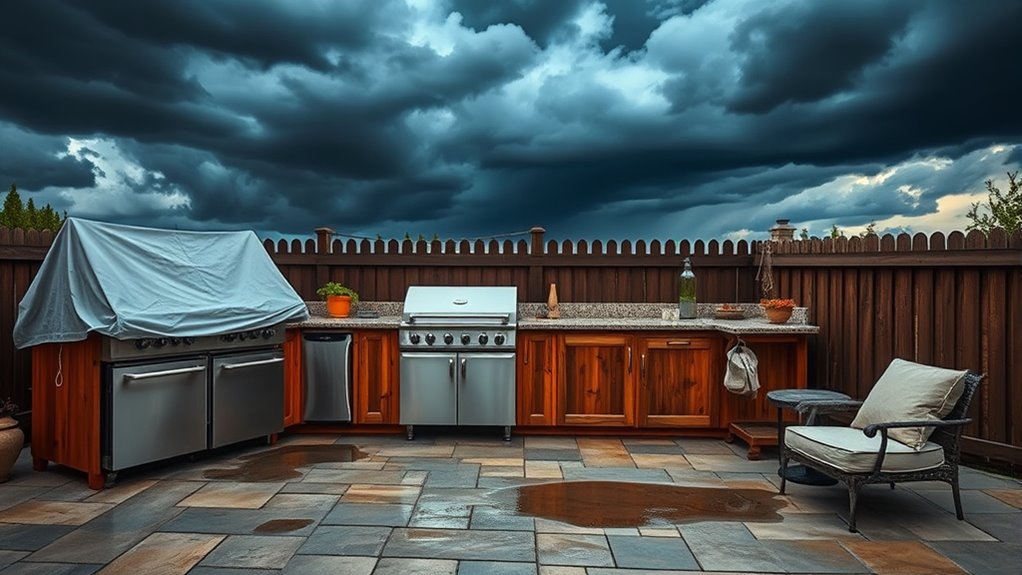
Many homeowners assume their outdoor kitchen is fully weatherproof, but this isn’t always the case. Even with weather-resistant furniture, exposure to heavy rain, wind, and humidity can cause damage over time. Applying stormproof coatings on surfaces and appliances adds an extra layer of protection, helping prevent rust and deterioration. These coatings are designed to withstand harsh conditions, ensuring your outdoor setup stays intact longer. Don’t rely solely on furniture made from weather-resistant materials; the entire structure needs protection. Many people overlook the fact that prolonged exposure can weaken materials, leading to costly repairs. By proactively using stormproof coatings and choosing furniture built to endure the elements, you can keep your outdoor kitchen looking great and functioning well, no matter what the weather throws your way. Regularly inspecting and maintaining your outdoor kitchen can also identify early signs of damage caused by exposure to moisture, helping prevent more serious issues down the line.
Overlooking the Importance of Covering or Moving Equipment Before Storms
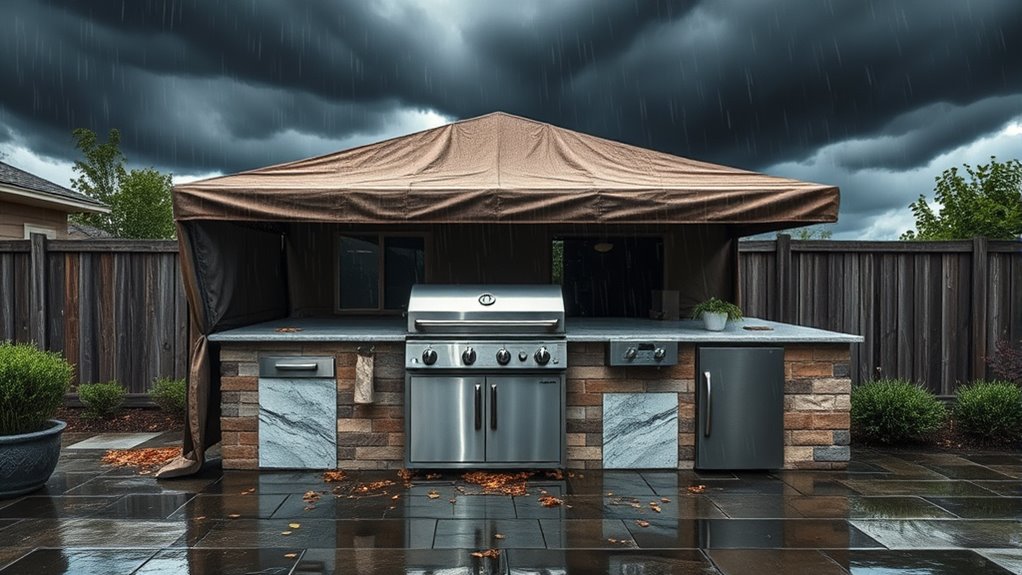
Failing to cover or move outdoor kitchen equipment before a storm can lead to unnecessary damage and costly repairs. Storm debris like fallen branches, leaves, and flying objects can cause dents, scratches, or more severe damage if equipment is left exposed. Covering equipment with durable, waterproof covers creates a barrier against debris and moisture, preventing corrosion and physical harm. Moving valuable or vulnerable items to a sheltered area minimizes the risk of damage altogether. Don’t underestimate the power of a strong storm—what might seem insignificant can turn into costly repairs if equipment isn’t protected. Taking these simple steps ensures your outdoor kitchen stays in good shape, saving you money and hassle when the storm passes. Proper preparation is key to lasting outdoor kitchen equipment. Additionally, understanding the importance of projector technology can help you make better decisions about equipment placement and protection during storms.
Assuming Storms Only Damage Outdoor Furniture, Not Structural Elements
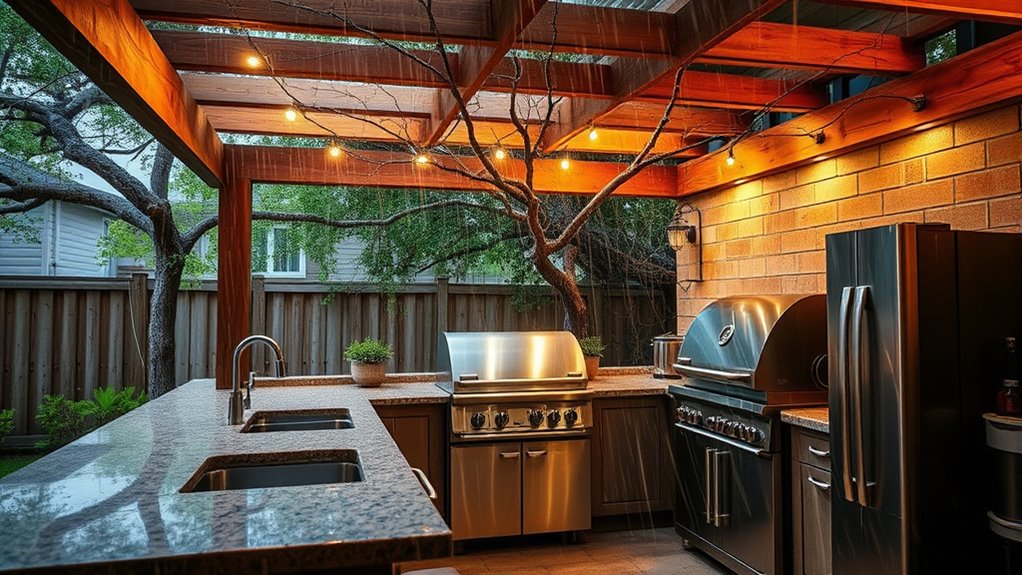
Storms don’t just threaten outdoor furniture; they can also cause significant damage to the structural elements of your outdoor kitchen. Ignoring this risk can compromise your setup’s structural integrity and foundation stability. Heavy winds and rain can loosen or crack support beams, destabilize the foundation, or cause water infiltration that weakens the entire structure. Moreover, security risks related to structural damage can increase if the outdoor kitchen is not properly inspected and maintained after storms. Cracked or shifted foundation leading to instability, damaged or compromised load-bearing elements, water seepage causing rot or rust on structural parts, and misaligned or warped framing affecting overall safety.
Forgetting to Secure or Store Valuables and Small Appliances
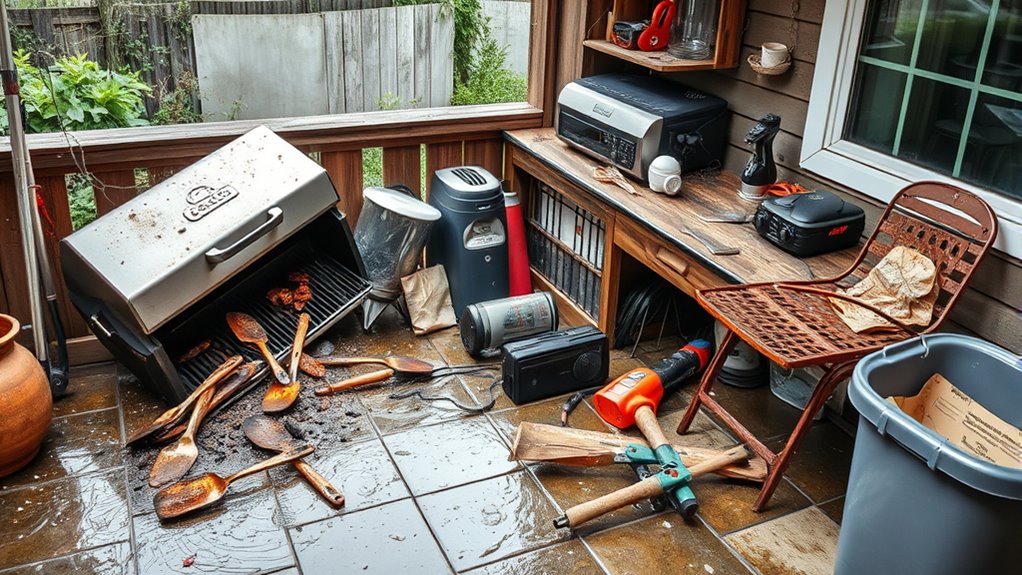
While securing the structural elements of your outdoor kitchen is essential, don’t overlook the small items that can quickly become hazards or get damaged during a storm. Valuable items, like jewelry or electronics stored nearby, should be brought inside or stored securely. Small appliances such as grills, mixers, or portable heaters need to be unplugged and covered or stored in a safe spot. Leaving these items exposed increases the risk of damage from wind, rain, or debris. Additionally, unsecured valuables can become dangerous projectiles if the storm intensifies. Take the time to gather and store small appliances and valuables in a protected area. Proper equipment maintenance and securing all items minimizes potential damage and keeps your outdoor space safe during severe weather.
Ignoring Drainage and Water Management Systems During Storm Prep

Ignoring drainage and water management systems during storm prep can lead to serious flooding and water damage in your outdoor kitchen. Without proper storm drain maintenance, excess water can pool, damaging surfaces and fixtures. Water runoff management is essential to prevent soil erosion and prevent water from seeping into electrical components. Failing to clear debris from drains or check for blockages can cause backups, worsening flooding risks. Properly managing water flow also protects landscaping and reduces mud buildup. To avoid these issues, ensure your storm drains are clear, check for proper slope and drainage pathways, and consider installing additional water runoff solutions if needed. Regular maintenance keeps water flowing away safely, minimizing damage and keeping your outdoor kitchen ready for any storm. Additionally, understanding the pollution and hydrogen fuel cell impacts of water runoff can help you implement more environmentally friendly drainage practices.
Underestimating the Damage Wind and Debris Can Cause to Fixtures and Surfaces
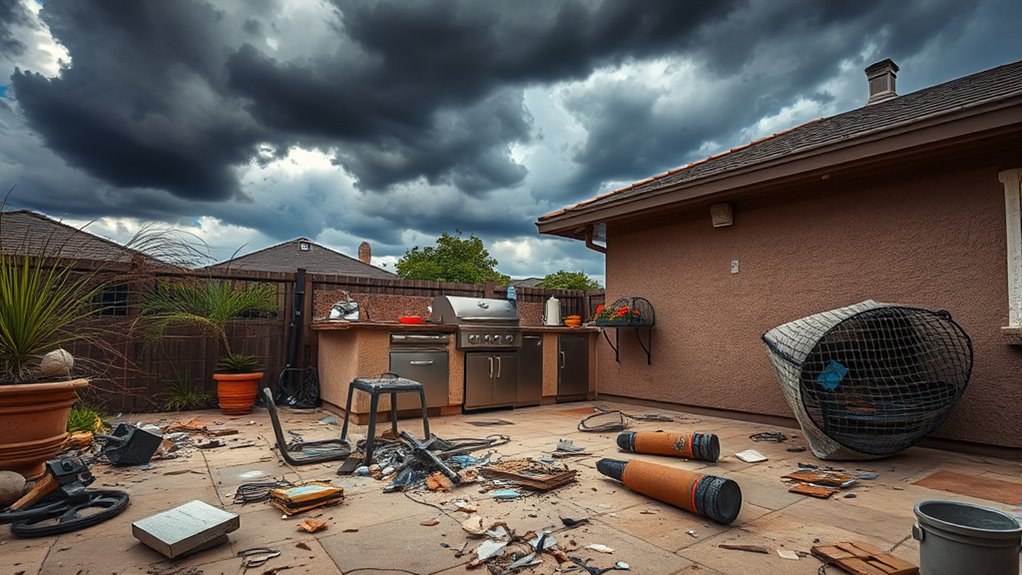
Wind and flying debris can cause significant damage to your outdoor kitchen’s fixtures and surfaces if you underestimate their power. Strong gusts and projectiles can lead to costly wind damage and debris impact, chipping countertops, shattering glass, or bending fixtures. To prevent surprises, recognize how vulnerable your setup is during storms. Secure all loose items and consider outdoor kitchen maintenance to reinforce vulnerable areas before severe weather hits. Stay alert and don’t ignore the threat wind and debris pose—they can damage your outdoor kitchen in seconds.
Relying Solely on Waterproof Materials Without Proper Maintenance
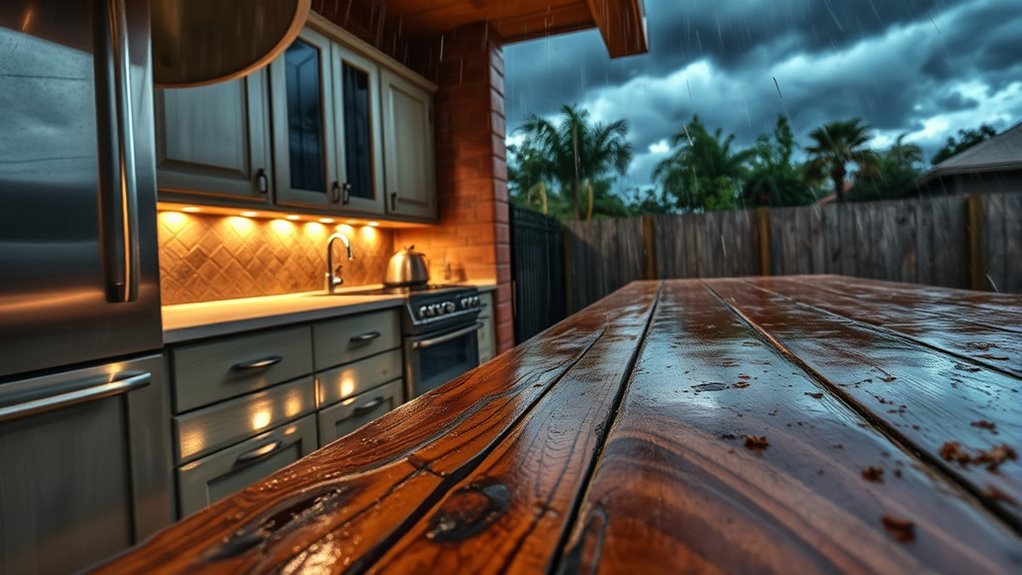
Relying solely on waterproof materials might give you a false sense of security, but without proper maintenance, those materials can fail over time. Waterproof coatings can degrade, crack, or peel without regular upkeep, exposing your outdoor kitchen to water damage. To avoid surprises, stick to a consistent maintenance schedule that includes inspecting and reapplying coatings as needed. Neglecting this step can lead to costly repairs and compromised surfaces. Keep an eye out for signs of wear, such as bubbling or discoloration, and address them promptly. Remember, waterproofing isn’t a one-and-done task—it requires ongoing attention to ensure your outdoor kitchen stays protected against storms and moisture. Regular inspections help identify potential issues early and prolong the lifespan of your waterproofing efforts. Proper maintenance keeps your investment secure and functional for years to come.
Neglecting Regular Inspection and Maintenance of Protective Coverings

While waterproof coatings are designed to protect your outdoor kitchen, their effectiveness diminishes if you don’t regularly inspect and maintain protective coverings. Over time, coverings can wear, tear, or become dislodged, exposing your appliances and surfaces to damage. Skipping routine inspections means you might miss small issues before they escalate, such as holes or loose fittings. Incorporate regular inspection routines into your storm prep schedule to catch problems early. Check for signs of deterioration, ensure coverings remain secure, and clean off debris that can cause wear. Proper upkeep of protective coverings is essential to prolong their lifespan and keep your outdoor kitchen safe during storms. Regular maintenance checks can help identify potential vulnerabilities before they lead to costly repairs later on. Neglecting this step leaves your setup vulnerable and could lead to costly repairs later on.
Assuming Storms Are Rare and Not Preparing Proactively
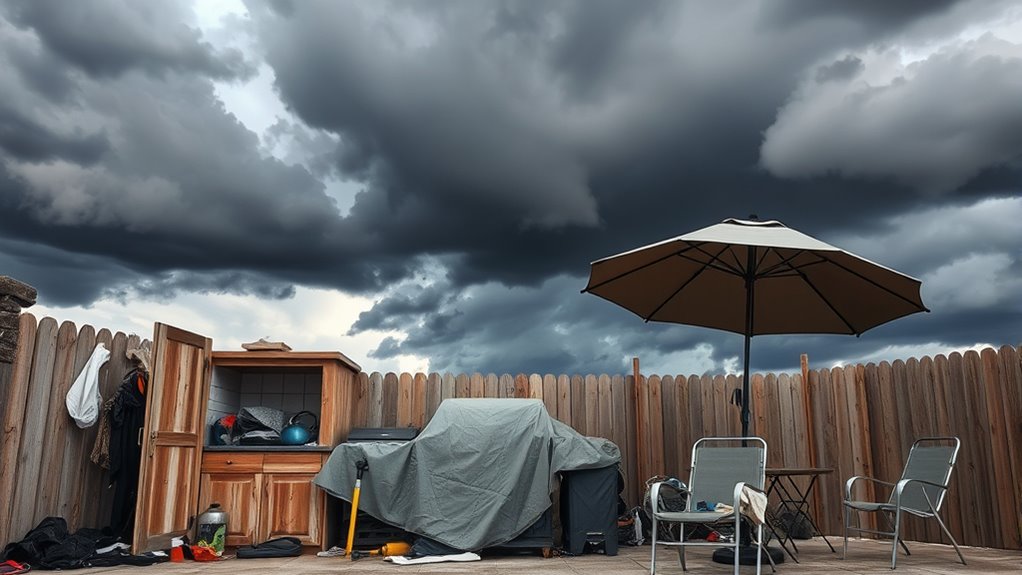
Many outdoor kitchen owners assume that storms are infrequent and therefore don’t need to prepare proactively. However, storm frequency can vary, and relying solely on past experiences is risky. Weather forecasting has improved, giving you early warnings, but you still need to act in advance to protect your setup. Ignoring this can lead to costly damage or unsafe conditions. For optimal protection, consider integrating advanced weather monitoring tools to enhance your preparedness strategy.
Assuming storms are rare can lead to costly damage; proactive preparation is essential.
- Monitor weather forecasts regularly for timely alerts
- Secure or cover furniture and appliances ahead of storms
- Clear debris and loose items that could become projectiles
- Check storm preparedness plans and update them seasonally
Preparing proactively ensures your outdoor kitchen survives storms unscathed. Don’t wait for a storm to hit—anticipate and act now for peace of mind.
Frequently Asked Questions
How Often Should Outdoor Kitchen Covers Be Inspected for Storm Readiness?
You should inspect your outdoor kitchen covers at least twice a year, especially before storm seasons. Regular checks make certain your covers fit well and aren’t damaged, protecting your appliances from weather. While inspecting, consider your garden layout and pest control measures to prevent pests from nesting under the covers. Keeping an eye on these details helps maintain your outdoor space’s durability and safety during storms.
What Are the Best Materials for Storm-Resistant Outdoor Kitchen Fixtures?
You should choose storm-proof fixtures made from weather-resistant materials like stainless steel, aluminum, or coated cast iron. These materials withstand harsh conditions and prevent rust or corrosion. Look for fixtures specifically designed for outdoor use, with secure fittings and durable finishes. Investing in high-quality, weather-resistant fixtures guarantees your outdoor kitchen stays protected during storms, minimizing damage and maintenance costs. Always verify the manufacturer’s specs for storm readiness and durability.
Can Storm Damage to Outdoor Kitchens Be Fully Repaired Afterward?
Storm damage to outdoor kitchens can’t always be fully repaired, but effective repair strategies can restore functionality and appearance. You should assess the damage, replace or reinforce compromised fixtures, and consider professional restoration if needed. While some structural issues may be permanent, proactive maintenance and timely repairs help minimize long-term impact. Keep in mind that thorough inspections after storms guarantee you catch damage early and implement the best repair strategies.
How Do I Properly Store Outdoor Appliances During Severe Weather?
When a storm’s brewing, don’t wait—act quickly. Weatherproofing tips are key; you should store outdoor appliances in sturdy, waterproof storage container options like heavy-duty plastic bins or custom cabinets. Keep electronics unplugged and covered, and make certain all gas lines are sealed. This proactive approach minimizes damage. By following these steps, you safeguard your outdoor kitchen, giving you peace of mind, even when severe weather threatens your space.
Are There Specific Maintenance Routines to Enhance Storm Resilience?
To enhance your outdoor kitchen’s storm resilience, you should regularly apply storm proof paint to protect surfaces and guarantee gutters are clear for proper drainage. Check and tighten all fixtures, seal gaps, and inspect for vulnerabilities before storms hit. Keep appliances covered or stored, and trim nearby trees to prevent damage. These routines help minimize storm-related harm and keep your outdoor space safe and functional during severe weather.
Conclusion
Think of your outdoor kitchen as a ship braving stormy seas—you can’t just trust the sturdy hull. By addressing overlooked vulnerabilities and preparing proactively, you shield your space from the chaos beyond the horizon. Don’t wait for the tempest to strike; be the captain who charts a safe course. With mindful maintenance and foresight, your outdoor kitchen can weather any storm, turning potential wreckage into calm waters.
